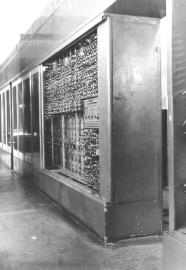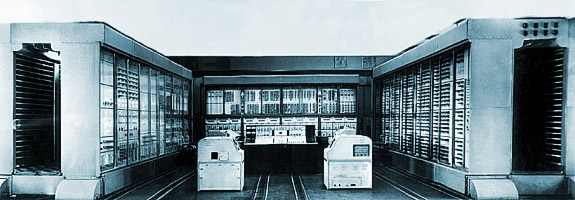| Sergei Lebedev and Early Russian computers |
| Written by Mike James | ||||
Page 2 of 3
Commissioning MESMBy the end of 1949 the main framework of MESM was in place and work was progressing on the individual units. In middle of 1950 the units were installed in the main frame and testing began. As with all new machines there were unexpected problems but when you are working with valves even loose wires can be lethal! They had to install an insulated shield between the electronics and the mainframe to avoid losing engineers. Apart from avoiding electrocution their main problem was the poor quality of Russian valves. They needed 6000 valves and the production quality was such that valves of the same type varied greatly in their performance. They tested hundreds to build a single flip flop and even then the valves aged in use and changed their characteristics. A partial solution was to age the valves for 30 hours before selecting them and building the flip flops. Another problem was that the tubes took time to warm up, two hours or more, before they were ready to operate reliably. The solution to this one was to leave the machine on 24 hours a day. However they had to leave a "night watchman" on guard to make sure that the 25KW machine didn't catch fire! During the winter the temperature in the machine room was a high 30 degrees; in the summer it could reach an unbearable 40! The heat often became so high that the machine became unreliable and it had to be shut down. In November 1950 the machine was ready enough to be used for its first test. Two of the engineers working on MESM described one of the machine's early successes: "And thus, finally, our MESM began to take its first working steps. Merely to think about the question given to it from the control panel: "how much is 2 times 2?" - to the great joy of all of us - it almost always answered "4"." MESM was demonstrated to the Ukrainian Academy of Sciences and officially commissioned. But even as before it had proved that it would work Lebedev was already thinking of enhancements. It was hoped that the improved MESM could be operational by the end of 1951. This is where the confused politics and infighting of the Soviet state enter the picture. In theory the planned economy should have funded an important project like MESM and its successors but it didn't work out like this. It was suggested that the project move to Moscow, which would cause serious delays, and the support from the Ukrainian Academy was patchy. The lack of enthusiasm was probably a lack of understanding of what the new computer could do and more importantly what it could be used for. A real stored program computerBy the end of 1951 the enlarged MESM was ready to be used for real problem solving. It had a speed of 50 operations per second, a fixed point word length of 17 bits and a three-address 20-bit operation code. The main operating memory used flip-flops to store 31 numerical values and 63 commands. A second read only memory had the same capacity and there was a 5000 word magnetic drum. A 250,000 word tape drive was used for initial input and output and, of course, there was a punch card reader. It is clear that MESM was a real stored program computer and not just an over-sized calculator. The improved MESM was an important machine - mathematicians travelled to Kiev to use it from all over the USSR. It was used for ballistics and rocket technology. It was even used for Lebedev's original problem - transmission line calculations - in particular the solution of the set of non-linear differential equations that defined the stability of the high voltage lines between the Kuibyshev power station and Moscow. The MESM was used by one of he greatest Soviet mathematicians - Alexey Lyapunov (1911 – 1973) - who created a formal method of programming. He was one of the first scientists to recognise that programming was a distinct and scientific discipline. During 1952 and early 1953 the MESM was the only stored program computer in the USSR. in this video Boris Malinovsky, who worked on MESM and is now a leading expert on Soviet-era computing, talks about Lebedev and MESM:
If you don't speak Russian click the Caption button for subtitles If you would like to see a video of MESM then look at around 3mins 50 seconds in on this video:
BESMLebedev moved to Moscow in 1950 and became head of a new computer research group. He started over again training the new technicians and telling them about the BESM (БЭСМ) Bolshaya Elektronno-Schetnaya Mashina or High Speed Electronic Calculating Machine. He swapped teaching students about digital computers for their help in building the new machine. Because of the success of the MESM a second computer project was started in Moscow to compete with Lebedev's BESM. In a free market competition would be natural but in a planned economy it too had to be planned. In this case the competition would be more political than technical. Repeatedly Lebedev's project suffered because the alternative project - Strela (arrow) - managed to secure scarce resources. Both machines were destined for completion at the start of 1953. Lebedev's design was very similar to the MESM - a three-address 39-bit floating point machine. The memory was to be based on CRT storage devices 1024 words in size. Each CRT could only hold 1024 bits so at least 39 tubes would be needed. As you can guess CRT tubes were in short supply, as were standard valves. For a brief period the valve shortage was solved by the ingenious offer of the BESM acting as a test site for the output of the factory. Unfortunately the Strela project had managed to secure the only source of CRT tubes and so the BESM lacked a memory. Lebedev was forced to redesign the memory to work with mercury delay lines.
BESM In early 1953 the BESM was ready to be used but with the delay line memory it only managed 1000 operations per second. The Strela worked at 2000 operations per second and had a simpler command structure and less external storage. Even with its electrostatic storage it was a very definitely less powerful machine but because of political influences BESM did not get the support it needed and deserved. The Strela was designed to be mass produced and it did go into full production - the first commercial Russian computer. BESM did eventually get its CRTs and using these its performance jumped to 7000 to 8000 floating point operations per second. However the CRT tubes were delivered just at the point where they were almost obsolete. Experiments with core memory had proved the technology and soon after BESM was fitted with a 1K x 40 bit core memory.
Strela
BESM was a powerful machine and was soon being used for fundamental scientific calculations - orbits of planets and asteroids and even advanced projects such as machine translation and chess playing. Despite the restrictions of a small main memory the experience with BESM was sufficient to convince many that a new machine age had dawned. |
||||
| Last Updated ( Thursday, 02 March 2017 ) |

